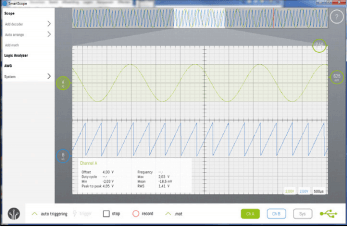SmartScope: Multi-Platform Measuring Instrument

can be shown at the top of the display,
from where you can select a section and zoom in on it.
Software
One of the most important goals that the developers had in mind was that the software should run under almost any operating system, with an identical user interface. This is something they’ve certainly accomplished. As far as we know, this is the only scope that works on virtually all operating systems: Windows 7/8, Linux, OS X, iOS (jailbroken) and Android 4.0+. It can therefore run on a standard PC or a laptop, but also on a tablet or a smartphone.The developers also felt that the controls on most USB scopes were somewhat limiting. The user interface is usually some sort of copy of that found on hardware scopes, which has been in existence since the fifties. The whole control panel including the knobs is often simulated on the screen, or pull-down menus are used for all kinds of settings. This was thought to be a bit out of date, and found not to be very intuitive. The software for the SmartScope had to be different and should make use of modern interfaces such as touchscreens. This didn’t appear to be very difficult at first, but it required a lot of thought and hard work before a functional alternative was created. The result is a control surface that reminds you of your first experience with a tablet or smartphone: it is a bit strange to start with, but it soon feels right. It’s as if you’ve given somebody their first tablet: they’ll play with it for a bit and after quarter of an hour it looks as if they’ve been using it all their life. The same happens with the software for the SmartScope. It takes a little bit of time to get used to it, but then it becomes so obvious that you don’t want to return to the old-fashioned methods.
Read full article
Hide full article


Discussion (1 comment)